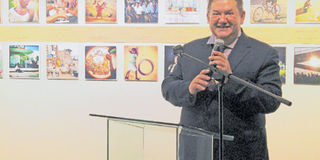Longest running film festival returns

The Ambassador of the European Union speaks at the launch of the festival. PHOTO| JAN FOX
What you need to know:
- The heroine of the film is Victoria (Laia Costa), a young pianist from Madrid working in a café in Berlin.
- The film starts in a club in the city’s Mitte district around 4am, with Victoria dancing alone and carefree.
- She then leaves towards the exit and meets a young local Berliner called Sonne (Frederick Lau) and his three dodgy-looking pals: Boxer, Blinker and Fus. Sonne opts for the cheesiest line in the book and promises to show her “the real Berlin,” as she’s new and knows nobody in the city.
“One girl. One City. One night. One take”. That’s the tagline of Victoria, the highly acclaimed German film chosen to open this year’s European Film Festival, held at Alliance Francaise and the Nairobi National Museum. The festival was launched on Monday, and when I found out Victoria had been selected for the opening night. I was disappointed.
Having done a bit of research on the film before the screening, it emerged that much of its success stemmed from the fact that it was shot in a single continuous take. An impressive feat for a two hour film. But rather than stir my curiosity, this put me off. The only other film I had watched with similar, albeit faked, seamless tracking shots was Birdman’ and I found the technique distracting. Birdman flaunts its technical trickery, diverting the audience’s attention from the central plot of the film. I thought Victoria would have a similar effect.
Thankfully, I was wrong. Director Sebastian Schipper and cinematographer Sturla Brandth Grøvlen use the limited time of their single take very wisely, and play tricks with duration to cleverly pace the action throughout the film. The quality of the single take technique allows the strength of characters to shine, and never distracts from the film’s exhilarating plot. Now and again, though, you remind yourself that the entire two hours is filmed in one shot, and you can’t help but admire the discipline of the actors.
The heroine of the film is Victoria (Laia Costa), a young pianist from Madrid working in a café in Berlin. The film starts in a club in the city’s Mitte district around 4am, with Victoria dancing alone and carefree. She then leaves towards the exit and meets a young local Berliner called Sonne (Frederick Lau) and his three dodgy-looking pals: Boxer, Blinker and Fus. Sonne opts for the cheesiest line in the book and promises to show her “the real Berlin,” as she’s new and knows nobody in the city.
Through hopeless naivety or a fearless openness to everything the night throws at her, Victoria decides to join them. It soon becomes clear to her that these four strangers are in trouble, and that they owe somebody a dangerous favour that requires repaying that same night.
DISASTROUS CONSEQUENCES
Enticed by Sonne’s charm, she agrees to come for the ride, with disastrous consequences. Over the next two hours, we follow the group as they traverse Berlin’s rooftops, and watch Victoria serenade Sonne with a brief piano recital, before Boxer leads them all into a remote underground car park to meet the sinister, leather-faced Andi (André Hennicke), for whom a debt needs to be repaid. From here, events take a menacing turn, and what began as a fun and reckless adventure quickly spirals out of control.
Before the screening at the launch of the festival on Monday, a Cultural Attaché of the German Embassy gave us a bit of background about the film. The film’s low budget permitted only three attempts at the one-take version.
According to the director, Schipper, the first attempt was dull because the actors were too cautious. The second attempt was the complete opposite as the actors went “crazy,” and Schipper worried that the experiment would fail. To his relief, after an angry meeting with the cast, the third and last attempt was perfect, with an aggression and tension that was absent from the first two takes. The script was also just 12 pages long, so most of the dialogue was improvised.
I recommend that you watch it – it’ll be screened again at the Nairobi National Museum on Tuesday 23 May, at 7.30pm. Although most of the films have already been screened this week at the Alliance Francaise, other films will be shown at the Museum next week, including “L’Oriana,” a drama from Italy, “Tokyo Fianceé,” a comedy from Belgium and “Gatos não Têm Vertigens” (Cat’s Don’t Have Vertigo), a comedy from Portugal. All of the films are free of charge.
Kenya’s European Film Festival has run for 26 years, since 1992. It has been coordinated by the Delegation of the European Union to Kenya, and aims to reflect Europe’s rich cultural diversity – a sentiment echoed by the Ambassador of the European Union Stefano A. Dejak, who spoke at the launch. The festival features contemporary films from European countries. Mr Dejak alluded to the motto of the European Union, “Unity in Diversity,” and considered the festival to be an effective means of showcasing the EU’s variety of cultures.
For the full schedule of the films have a look at the Delegation of the European Union to Kenya’s website: https://eeas.europa.eu/delegations/kenya_en or check out their Facebook page.
Jan Fox is a Director at iDC. Email: [email protected]





